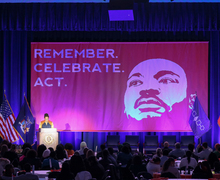City, campus volunteers plan to enhance bicycle safety
A group of volunteers from the Syracuse area are trying to make the city a safer place for hikers, walkers and cyclists.
CNY Pathways announced its citizen’s action plan to connect Syracuse and make it a safer place for alternative modes of transportation in a public meeting Friday. The plan includes improving crossing signals, painting new bike lanes, and connecting and mapping various trails in the city’s parks.
CNY Pathways formed a year ago by the volunteer coalition Forging Our Community’s United Strength, known as F.O.C.U.S., of greater Syracuse. The group’s volunteers include representation from residents, the city government, Syracuse University and the State University of New York College of Environmental Science and Forestry.
Part of the group’s report was a study about dangerous intersections in the city. Volunteers from AARP did study as part of the federal ‘Complete Streets’ legislation on the safety of the city’s intersections. Though the results of the report are not public, the city is using them to improve safety, said Paul Mercurio, Syracuse’s transportation planner.
‘The crossing time given by the lights at crosswalks is too short, and the city is planning on extending that time and updating the whole system this year,’ Mercurio said.
Safety and convenience for cyclists is another concern. The city plans on painting new bicycle lanes this year to connect existing ones and to make cycling safer in the city, Mercurio said.
Helping citizens take advantage of green space is another initiative of the group. Peter King, a student at ESF, has set up an interim website with maps of the Syracuse area showing trails for hiking or biking. The group hopes to expand on this website and even set up electronic walking tours in some parks.
‘The university neighborhood has plenty of trails and sidewalks we want to develop to connect the area with parks and cemeteries,’ said Chris Abbott from the department of parks, recreation and youth programs.
Zachary Samoila, a junior international relations major, said he supports new bike lanes and saw the advantage in making changes.
‘They should put them in,’ he said. ‘The streets usually aren’t a problem, but in the winter they can be dangerous for bikes.’
The group has also acquired a $175,000 grant from the federal Safe Routes to School Program to make it safer for children to walk to school in the city. This funding is already being put to use at three local schools.
Other than the one federal grant, the group is relying on volunteer work and advocacy, and many of its initiatives have no planned date of completion. One goal, building a trail all the way around Lake Onondaga, is estimated to cost $9 million.
‘We have people here from all over,’ said Chuckie Holstein, executive director of F.O.C.U.S. ‘We were looking to connect not just the city but the whole county and even other counties.’
Published on January 23, 2011 at 12:00 pm





